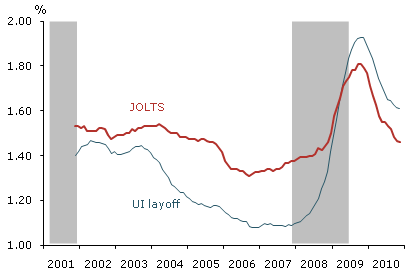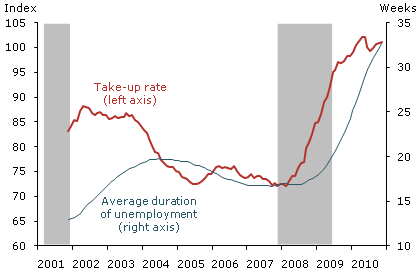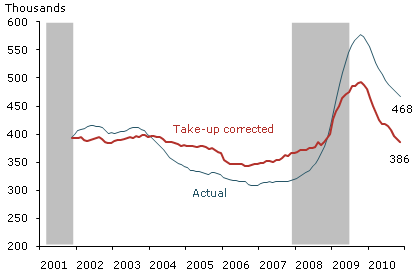Initial claims for unemployment insurance averaged a stubbornly high 468,000 in the year ending December 2010, but have recently come down quickly. Many analysts interpret this as a sign that layoffs were too high to support a strong labor market recovery during most of 2010. However, claims data may have exaggerated layoffs in 2010 because the fraction of unemployed workers applying for benefits was higher than before the recession. If the proportion of eligible workers who applied were held constant, 2010 claims would have averaged roughly 20% less than the actual reading.
The level of initial claims for unemployment insurance (UI) is a well-known leading indicator of labor market conditions. As the economy weakens, businesses begin to lay off workers, causing initial claims for UI to rise. Conversely, as the labor market begins to recover and layoffs subside, initial claims decline (Gordon 2009). Consequently, weekly initial claims tend to provide a timely measure of the strength or weakness of the labor market. During 2010, weekly claims averaged 468,000 nationwide, about 70,000 higher than what would be considered normal at that stage of the business cycle. The persistent high level of initial claims suggested continued U.S. labor market weakness even as GDP was expanding.
This Economic Letter considers whether such a reading of initial claims data is accurate. Our inquiry is based on the fact that initial claims increase not only when more people get laid off, but also when the UI take-up rate goes up. The take-up rate is the percentage of individuals eligible for unemployment insurance who claim and receive UI benefits. Thus, changes in the take-up rate make it harder to compare the level of initial claims over time. To begin to separate these two effects, we construct an alternative measure of initial claims that corrects for changes in the take-up rate. We estimate the take-up rate by using the U.S. Labor Department’s Job Openings and Labor Turnover Survey (JOLTS). This survey provides a direct measure of layoffs and discharges in the economy, thereby allowing us to infer the take-up rate.
We find that the take-up rate has increased significantly. During 2010, the average take-up rate was 37% higher than in 2007. This has caused the initial claims data to exhibit an upward bias as a measure of job losses. Our alternative measure of initial claims, which corrects for the take-up rate, lies significantly below the official readings for 2010. When initial claims are adjusted for corrections in the take-up rate, the average level in first eleven months of 2010 was 386,000, not the official 468,000.
However, it is crucial to note that the take-up rate itself is an indicator of the health of the labor market. It increases when the average duration of unemployment is high. And long-duration unemployment, of course, is an indication of poor job-finding prospects. Consequently, when we consider both UI claims and changes in the take-up rate, we find little evidence that the labor market was much stronger in 2010 than previously thought.
Two measures of layoffs
In the United States, the UI program provides benefits to eligible workers who are unemployed through no fault of their own. These workers file a claim with a local unemployment office to start collecting benefits. Each local office reports the number of claims to the U.S. Department of Labor. Every Thursday, the department publishes the total of initial claims filed nationwide. Economists use the initial claims data to judge the health of the labor market. The number of initial claims equals the number of layoffs times the fraction of laid-off workers eligible for unemployment insurance, known as the eligibility rate, times the fraction of these UI-eligible workers who file initial claims, known as the take-up rate. If the eligibility rate and the take-up rate do not change, then the initial claims number moves in direct proportion to layoffs. In this way, initial UI claims can be a good indicator of the extent of layoffs in the economy.
Figure 1
JOLTS and UI layoff rates (12-month moving average)

Source: Bureau of Labor Statistics (BLS), Department of Labor, and authors’ calculations.
Figure 2
UI take-up rate and average duration of unemployment (12-month moving average)

Source: BLS and authors’ calculations.
Figure 3
Actual and take-up adjusted UI claims (12-month moving average)

Source: BLS and authors’ calculations.
However, there is evidence that eligibility and take-up have changed over time. For example, during the recent recession, the UI system was expanded, allowing many more workers to apply for benefits. Moreover, UI participation increases during recessions as labor market conditions worsen (see Cleary, Kwok, and Valletta 2009). During periods when unemployment duration is high, the take-up rate may increase because workers believe that their chances of lining up jobs quickly are low.
To get a sense of how these factors have affected recent initial claims trends, we calculate two measures of layoffs, shown in Figure 1. The first is based on JOLTS data, which allow us to directly measure the fraction of workers who get laid off. The second is based on initial UI claims data, which allow us to measure the fraction of UI-eligible workers who file claims. Both measures move together, although the levels vary. During most of the sample period, the layoff measure based on UI claims lies below the JOLTS layoff measure. However, this has reversed in the past two years, which may reflect changes in the take-up rate.
To back out the take-up rate, we need not only initial claims data, but also measures of layoffs and the eligibility rate. To calculate layoffs, we use data from JOLTS. The use of this survey is subject to a caveat. The data may understate the number of workers who lose their jobs because the survey tends to miss rapidly shrinking establishments (Davis et al. 2008). The eligibility rate is the fraction of laid-off workers who qualify for UI. Figure 2 plots the resulting take-up rate, indexed to 100 in June 2010. Figure 2 also includes the average duration of unemployment. It shows that the take-up rate increases when the labor market is weak and falls when the labor market is strong. Unemployed workers are more likely to file for UI if they expect to be unemployed for long periods. In addition, UI benefits were extended up to 99 weeks during the recent downturn, which gives unemployed workers additional incentive to file UI claims.
Take-up adjusted unemployment insurance initial claims
Because of changes in the take-up rate, it is hard to use levels of initial claims to assess the magnitude of job losses, especially during the late stages of recessions. To have a consistent measure over time, we correct for changes in the take-up rate. In particular, we calculate the number of initial claims that would have occurred if the take-up rate had stayed constant at its average from December 2001 to June 2010. Figure 3 compares actual initial claims and claims adjusted for a constant take-up rate. The figure shows that adjusting the take-up rate increases the initial claims measure when the labor market is strong and decreases it when the market is weak. Both in 2001–2003 and 2008–2010, periods of recession or weak growth, initial claims adjusted for take-up lie below actual claims. For the 2001–2003 period, the difference between actual and take-up adjusted UI claims is not very high. However, for the most recent downturn, the adjustment makes a big difference. The 12-month moving average of actual initial claims is 468,000, but the take-up adjusted average is 386,000. In other words, correcting for the take-up rate lowers the level of initial claims about 20%. Such an adjustment brings the current level of initial claims closer to its pre-recession levels. As Figure 3 shows, the average take-up adjusted level of initial claims hovered around 350,000 in 2006.
Conclusion
Our analysis suggests that the level of initial claims in 2010 reflected not only the level of layoffs, but also the increased reliance of laid-off workers on the UI system, as measured by our calculation of a rising UI take-up rate. This increase in the take-up rate reflects both the extension of UI benefits and an increased fraction of laid-off workers filing initial claims because their prospects of finding jobs were dim. Of course, these two factors are not easy to separate.
These findings imply that, as long as the UI take-up rate remains high, initial claims readings will tend to stay high, even if layoffs fall to pre-recession levels. Moreover, recent declines in initial claims do not necessarily indicate a reduction in layoffs. Decreasing claims may also capture a decline in the take-up rate. We expect the take-up rate to decline even more when both UI policy on length of benefits and duration of unemployment return to more normal levels.
References
Davis, Steven J., R. Jason Faberman, John C. Haltiwanger, and Ian Rucker. 2008. “Adjusted Estimates of Worker Flows and Job Openings in JOLTS.” NBER Working Paper 14137.
Gordon, Robert J. 2009. “Green Shoot or Dead Twig: Can Unemployment Claims Predict the End of the American Recession?” VoxEU, May 1.
Cleary, Aisling, Joyce Kwok, and Rob Valletta. 2009. “New Highs in Unemployment Insurance Claims.” FRBSF Economic Letter 2009-28.
Opinions expressed in FRBSF Economic Letter do not necessarily reflect the views of the management of the Federal Reserve Bank of San Francisco or of the Board of Governors of the Federal Reserve System. This publication is edited by Anita Todd and Karen Barnes. Permission to reprint portions of articles or whole articles must be obtained in writing. Please send editorial comments and requests for reprint permission to research.library@sf.frb.org